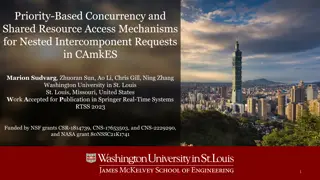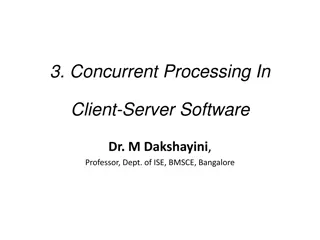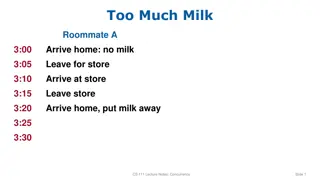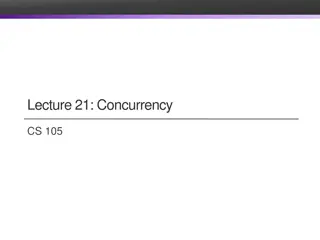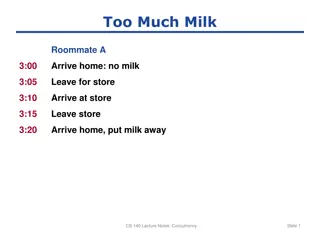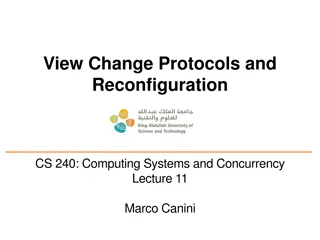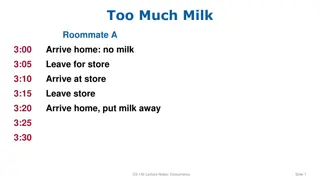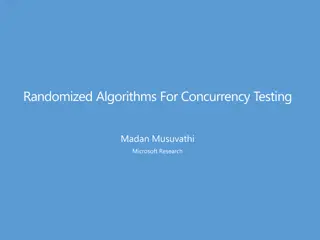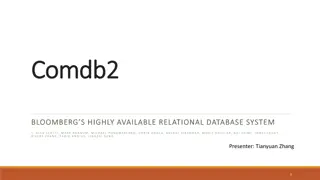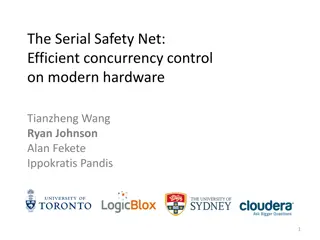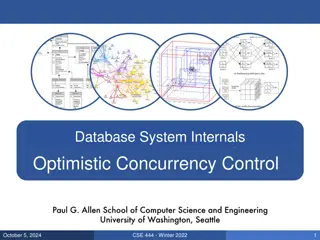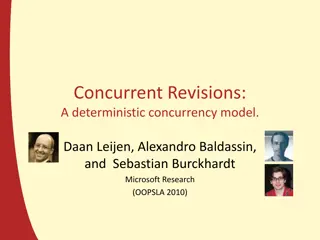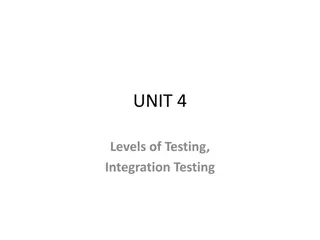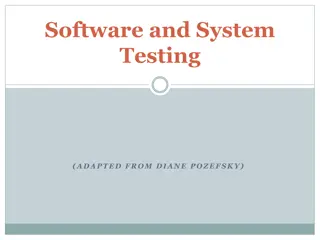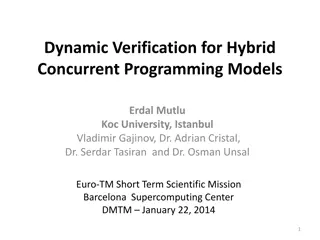A Concurrency Framework for Priority-Aware Intercomponent Requests in CAmkES on seL4
This research work proposes a concurrency framework designed to handle priority-based intercomponent requests efficiently in CAmkES on seL4. The framework supports reentrant execution, locked critical sections over shared state using IPCP, NPCS, and PIP protocols. It requires minimal changes to comp
0 views • 8 slides
Database System Concurrency Control and Transactions Overview
Studying relational models, SQL, database system architecture, operator implementations, data layouts, and query optimization laid the foundation for advanced topics like Concurrency Control and Recovery. Discover how transactions group related actions, ACID properties ensure data integrity, and the
0 views • 57 slides
Understanding Concurrent Processing in Client-Server Software
Concurrency in client-server software involves simultaneous computing processes among multiple users or processes within a network. Dr. M. Dakshayini explains the importance of concurrency in distributed computing and its various forms such as time-sharing and multiprocessing. The design and impleme
3 views • 26 slides
Understanding Software Testing Metrics and Tools
Software testing metrics play a crucial role in evaluating the quality and progress of the testing process. Metrics provide valuable insights into the readiness, quality, and completeness of a product. By measuring attributes such as defects, testing efficiency, and productivity, organizations can m
3 views • 100 slides
Fundamentals of Software Testing Explained
Software testing is a critical process to ensure that software applications meet requirements and are free of defects. It involves various activities such as test planning, analysis, design, implementation, and execution. Testing approaches like the Bing bang approach and Total Quality Management ar
1 views • 48 slides
Understanding Concurrent Processing in Client-Server Software
Concurrency in client-server software allows for simultaneous computing, involving multi-user systems, time-sharing, and multiprocessing. This concept is vital in distributed computing, occurring among clients and servers, as well as within networks. Developers design client programs without conside
3 views • 26 slides
Understanding Equivalence Class Testing and Its Application in Software Testing
Equivalence class testing is a software testing technique that involves dividing input values into classes for effective testing coverage. Equivalence classes are defined mathematically as subsets of a given set, ensuring partitioning and mutual exclusivity. By applying equivalence partitioning, tes
1 views • 21 slides
Uganda's Successes in Reaching Men with HIV Testing Through Assisted Partner Notification Program
Uganda has successfully implemented an Assisted Partner Notification (APN) program to reach men for HIV testing, addressing the gender gap in testing rates. By utilizing various approaches such as index testing, self-testing, and social network testing, Uganda has achieved significant success in tar
0 views • 12 slides
Key Points of Concurrency in Triangles
Understand the essential facts about points of concurrency within triangles. Learn about the Incenter located inside the triangle, the Centroid as the center of mass, and the Circumcenter as the point of concurrency of perpendicular bisectors. Memorize the characteristics and significance of these i
2 views • 10 slides
Software Testing Foundation Level: Testing Throughout the SDLC Quiz
Explore key concepts in software testing throughout the Software Development Lifecycle (SDLC) with a quiz covering topics like white-box testing in acceptance testing, component testing vs. system testing, and regression testing purposes. Enhance your understanding of testing methodologies with samp
5 views • 17 slides
Importance of Software Testing in Preventing Catastrophic Failures
Software testing is crucial in ensuring the reliability and safety of software systems, as highlighted by catastrophic failures such as the Ariane 5 rocket incident and the Therac-25 radiation therapy machine disasters. These examples underscore the importance of thorough testing in identifying and
1 views • 42 slides
Concurrency in Milk Management Scenario
The scenario explores a comical tale of roommates, A and B, dealing with the dilemma of milk shortages and excessive milk. Through a series of notes, images, and code snippets, the story unfolds as the roommates navigate buying and storing milk, with a touch of concurrency illustrated in their actio
0 views • 8 slides
Understanding Concurrency in Computer Science
Concurrency in computer science involves running multiple threads or processes simultaneously, providing responsiveness, managing I/O devices, and improving performance by utilizing multiprocessors. This concept allows programs to handle tasks more efficiently and effectively through parallel execut
0 views • 32 slides
Managing Milk Mishaps: A Concurrency Lesson
Learn about the comical scenario of roommates forgetting to buy milk, and delve into concurrency concepts through humorous anecdotes and code snippets. The lecture slides depict the chaotic yet educational journey of handling too much milk through synchronized threads and computerized milk purchases
0 views • 7 slides
Testing Approach in SCREAM for E3SM Fall All-Hands 2019
Major effort is focused on verification and testing in SCREAM for the E3SM Fall All-Hands. The initiative includes unit testing, property testing, regression testing, and leveraging various tools like Cmake, Python, Jenkins, AutoTester, and GitHub for Continuous Integration (CI). The emphasis is on
1 views • 21 slides
Real-World Concurrency Bugs and Detection Strategies
Explore the complexities of real-world concurrency bugs through a study of 105 bugs from major open-source programs. Learn about bug patterns, manifestation conditions, diagnosing strategies, and fixing methods to improve bug detection and avoidance. Gain insights from methodologies evaluating appli
0 views • 20 slides
Understanding Replica Management in Computing Systems and Concurrency
Introduction to replica management in computing systems and concurrency, covering primary-backup replication, transitioning from two to many replicas, and exploring Viewstamped Replication for increased fault tolerance and scalability. The concept of Replica state and Normal operation scenarios are
0 views • 40 slides
Concurrency in Daily Life: The Milk Run Saga
Multiple threads of activity unfold as Roommate A and Roommate B experience a series of events involving a lack of milk, store visits, and automated purchasing attempts. The narrative traverses the comical mishaps and coordination challenges faced in everyday tasks, depicted with a touch of humor an
0 views • 8 slides
Exploring Real-World Concurrency Bugs in Go Programming Language
Golang, a programming language designed for efficient concurrency, utilizes lightweight threads called goroutines. This study delves into 171 Go concurrency bugs from various sources, analyzing root causes and fixing strategies. Highlighted results reveal insights for developers, pointing out that m
0 views • 36 slides
Understanding Probabilistic Concurrency Testing for Bug Detection
Explore the concept of probabilistic concurrency testing and how randomized scheduling algorithms can help detect bugs efficiently. Learn about bug depth, randomized algorithms, and the development of PCT to improve the effectiveness of stress testing tools like Cuzz.
0 views • 23 slides
Challenges and Solutions in Concurrency Testing with Randomized Algorithms
Concurrency testing in complex cloud services presents challenges such as bugs, performance problems, and data loss. Randomized algorithms, like Probabilistic Concurrency Testing (PCT), offer effective bug-finding solutions. PCT provides probabilistic guarantees and scalable bug detection for distri
0 views • 37 slides
Understanding Testing in Software Engineering
In the previous session, we discussed various aspects of software engineering, including modeling with UML diagrams, such as activity diagrams, use case diagrams, sequence diagrams, state diagrams, and class diagrams, as well as architecture patterns. Testing was emphasized as a key aspect, highligh
0 views • 35 slides
Highly Available Relational Database System - Key Components and Design Choices
A comprehensive overview of a highly available relational database system, focusing on scalability, concurrency control options, data replication, availability strategies, failure handling, and full transactional support. The content discusses essential elements such as optimistic concurrency contro
0 views • 21 slides
Understanding Gray Box Testing in Software Development
Gray Box Testing is a software testing technique that involves testing the software with partial knowledge of its internal workings. It combines aspects of White Box Testing and Black Box Testing, allowing testers to check both the presentation layer and the code part of an application. Gray Box Tes
0 views • 14 slides
Understanding Concurrency in Go Programming
Concurrency in Go involves the composition of independently executing functions, not parallelism. Key concepts include goroutines, channels for communication, achieving concurrency through communicating sequential processes (CSP), and Go's philosophy of memory sharing through communication. This art
0 views • 13 slides
Efficient Concurrency Control on Modern Hardware
This research explores efficient concurrency control mechanisms on modern hardware, addressing issues related to CPU utilization, locks, threads, memory management, and disk operations. It delves into the current state-of-the-art techniques and the importance of robustness in ensuring fast, fair, an
0 views • 17 slides
Systematic Testing of Reactive Software - A Case Study on LG Electric Oven
Overview of a case study conducted on LG Electric Oven using systematic testing of reactive software with non-deterministic events. The study focused on detecting concurrency bugs in the software controller of the oven through an automated testing framework that generates event timing sequences. It
0 views • 32 slides
Enhancing Concurrency in Distributed Transactions
Explore the challenges and solutions in achieving higher concurrency levels in distributed transactions, focusing on techniques such as optimistic concurrency control and two-phase locking. The importance of maintaining serializability to prevent angry customers and the impact of contention on scala
0 views • 27 slides
Understanding Requirements-Based Testing in Software Development
Dive into the world of requirements-based testing in software development, exploring main concepts, test levels, testing roles, and the importance of testing your solution and modeling case. Learn about test cases, different testing activities, and the significance of acceptance testing in identifyi
0 views • 16 slides
Understanding Concurrency in Operating Systems
Concurrency is a crucial feature in modern operating systems, enabling concurrent execution of processes/threads. It involves issues like communication, synchronization, resource sharing, and contention. This discussion explores design problems, solutions, principles of concurrency, interactions amo
0 views • 40 slides
Understanding Concurrency Control in Database Systems
Dig into the world of concurrency control in database systems, exploring topics such as pessimistic vs. optimistic concurrency, snapshot isolation, and the importance of timestamps in ensuring transaction order and recoverability. Learn about the mechanisms behind preventing unserializable schedules
0 views • 50 slides
Concurrent Revisions: A Model for Deterministic Concurrency
This content discusses a deterministic concurrency model called Concurrent Revisions, focusing on interactive applications with large shared data structures. It covers the challenges of conflicting tasks, conventional concurrency control methods, and proposes a programming model based on revisions a
0 views • 41 slides
Guidelines for HIV Testing During Pregnancy and Postpartum
These guidelines recommend HIV testing during pregnancy, at delivery, and postpartum. Testing should be done early in pregnancy and again in the third trimester. Expedited testing during labor is required for certain patients, and syphilis testing is recommended. Pre-exposure and post-exposure proph
0 views • 18 slides
Concurrency and Memory Sharing in Java Programming
Understanding concurrency and memory sharing in Java programming is crucial for managing shared resources efficiently. This includes concepts like ForkJoin, shared queues, and synchronized situations in examples like bank accounts. Proper synchronization is essential to prevent simultaneous access i
0 views • 59 slides
Comprehensive Overview of Fault Modeling and Fault Simulation in VLSI
Explore the intricacies of fault modeling and fault simulation in VLSI design, covering topics such as testing philosophy, role of testing in VLSI, technology trends affecting testing, fault types, fault equivalence, dominance, collapsing, and simulation methods. Understand the importance of testing
0 views • 59 slides
Understanding Unit Testing in Software Engineering
Concept Software is a discipline comprising various code pieces. Testing these codes together is complex but vital in Software Engineering. The process includes early testing like unit tests, pairwise/multiple component testing, module testing, integration testing, user tests, alpha tests, beta test
0 views • 6 slides
Understanding Integration Testing and Levels of Testing
Explore the importance of integration testing in software development, covering topics such as traditional testing levels, the SATM system, goals and purposes of integration testing, testing level assumptions and objectives, software process overview, various approaches to integration testing, and t
0 views • 39 slides
Concurrency Control and Coordinator Election in Distributed Systems
This content delves into the key concepts of concurrency control and coordinator election in distributed systems. It covers classical concurrency control mechanisms like Semaphores, Mutexes, and Monitors, and explores the challenges and goals of distributed mutual exclusion. Various approaches such
0 views • 48 slides
Importance of Software and System Testing
Understanding the critical role of software and system testing in identifying and fixing errors before they lead to major failures. Various types of testing such as functional, usability, performance, and reliability testing are essential to ensure the quality of software products. Different classif
0 views • 52 slides
Dynamic Verification for Hybrid Concurrent Programming Models
This content discusses dynamic verification for hybrid concurrent programming models, focusing on shared memory, transactional memory, message-passing, and data-flow models. It explores the motivation, proposed solutions, and ongoing work in this field. The importance of testing and verification in
0 views • 15 slides
